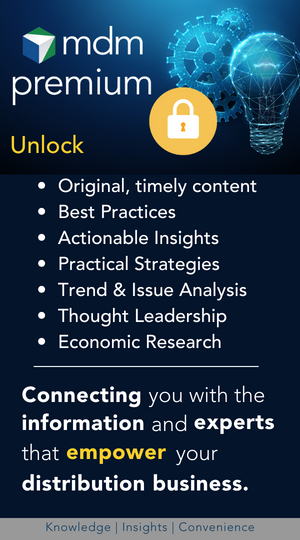One of the most important recent trends is the accelerated interest and involvement of private equity investors in wholesale distribution. Stuart Mechlin's blog on mdm.com focuses on thinking differently by using a Private Equity Investor Framework. He recommends distributors think more like investors to add value to their businesses. This is his third blog post for MDM.
In previous blogs, Mechlin examined why it’s important to think like an investor and the importance of Additional Value Creation.
From Benjamin Graham (The Intelligent Investor) to John C. Bogle (The Clash of the Cultures: Investment vs. Speculation), looking at investments through a portfolio lens has been a guiding principle for superior long-term returns and the mitigation of risk. The best private equity investors and fund managers view their private equity funds as portfolios.
The portfolio concept can help you better analyze the segments of your business, wherever you have assets deployed.
You are familiar with the portfolio concept if you own any kind of equity, bond, real estate or other investment fund. If you're familiar with the major investment companies – such as Charles Schwab, Vanguard, Fidelity, BlackRock – you are familiar with portfolio strategies. You know it works because you count on the development and execution of the strategies to deliver superior returns and manageable risk, for our personal finances, over time.
However, you may argue that your company’s underperforming Segment A allows us to execute on Segment B, which is over-performing. Or you may argue that it’s easy to reallocate a portfolio, when you have a market in which you can buy and sell assets, but that doesn’t work in the company I’m running.
It’s true we’re not running private equity investment funds. We are running basic industrial distribution firms. But all too often we fall back into our comfort zone of how we’ve always done business without even realizing it and without recognizing that there are equally valid, proven models that can deliver better decisions.
Here’s how the portfolio concept can be applied to wholesale distribution businesses:
Diversification: This concept can be applied to all aspects of your company – business segments; customer concentration; receivables management; suppliers; geographies – as a way to even out your peaks and valleys. An example of this in end-markets is a traditional industrial distributor investing in countercyclical markets such as health care. Another example in marketing is employing both direct sales and Web-based selling, the latter of which delivers revenue from a broader customer base at a lower cost-to-serve than traditional business.
Risk management: You must be a risk manager in the best traditions of an insurance actuary, a corporate safety officer or a fireman (like my son). Like them, you have to be constantly reviewing and reevaluating objective facts from multiple sources. Like them you have to be assessing assumptions with a healthy skepticism. The risks of an end-user switching contracts, a competitor delivering service more cost effectively or ERP system chaos can never be eliminated. However risk can be mitigated and reduced.
Asset allocation: Assets should be generating, or have the potential to generate returns, so keep to a minimum or avoid the consequences of choosing the wrong allocations. For example, assets should be used on a specific, granular level with attendant specific current or expected return. Disciplining your thinking this way will produce better decisions than just saying: “We are going to grow in XYZ geography” or “We're going to roll out vending machines.” Don’t lump the assets needed to do both and the expected returns in with everything else.
Rebalancing and tactical asset allocation: Sell or reduce your investment in overvalued assets and rotate those into undervalued assets that can generate greater return.
Let’s go deeper into rebalancing and tactical asset allocation. Think about the words in this definition. “Rebalancing” implies trade-offs and coming back to stasis. “Tactical” implies a bias toward ongoing, immediate action. “Allocation” implies making decisions.
It’s important to frequently assess your business and adjust your decision-making based on that assessment. For example, you may decide that a potential long-term return, as yet unrealized, may be a better use of new assets than something that we do because we have always done it.
Or you may want to reduce the assets applied to customers that have lower returns and redeploy that asset value to customers that are or can generating commensurate and/or superior returns.
As management guru Peter Drucker says: “What managers decide to stop doing is often more important than what they decide to do.”
The portfolio concept with its siblings, Additional Value Creation and Trends Analysis (which I will cover in a future blog post) are the main engines that power the Private Equity Investor Framework.
The Private Equity Investor Framework and, with it, the portfolio concept may be uncomfortable and awkward to us at first blush. However, these are by and large mainstream concepts that fit in nicely with what most of us consider good short- and long-song distribution management practice. This concept is not a radical change but merely an extension of what we do. And the best of us – of all geographies, verticals and sizes – are already there, executing for competitive advantage and profitability.
In my next blog post, we’ll look at another component of the Private Equity Investor Framework.
After 18 years in the wholesale distribution industry, including the role of senior vice president of Affiliated Distributors’ Industrial Supply Division, Stuart Mechlin is actively engaged in working with distributors and suppliers on profitability and growth strategy. He is a member of several wholesale distribution company boards of directors. Mechlin has worked for several best-practice companies, including McDonald’s and Fel-Pro. He is also a member of MDM's Editorial Advisory Board. Contact him at stuart.mechlin@gmail.com or connect at www.linkedin.com/in/stuartmechlin.


